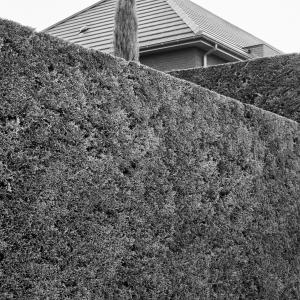
No Place Like Home
The series depicts a society that is characterized by an impenetrability and closedness. While the people of this society live closely together, they behave very distant towards one another. They each seem to long for a personal paradise in which anything foreign appears to be completely unwelcome. Tall hedges and sturdy wooden palisades are used to demarcate the personal property and to block the presence and gaze of the outsider. These constructions might seem innocent at first, but they hint at more troublesome contemporary issues: distrust, a trend towards more and more individualization, the inability of people to connect to each other and a fading sense of community.
No Place Like Home also hints at another conflict: that between man and its surroundings. The precisely trimmed hedges and bushes in the pictured suburban environments have an incredible aesthetic and sculptural aura. However, the meticulous truncation of these plants is also an expression of a strong urge to govern and to control life. While this need to dominate is questionable, there is a certain beauty in people’s attempts to control the cyclical and regenerative character of nature and to freeze the shrubs in a seemingly permanent state.
Photography is a medium of power. We live in a world that is shaped by the images that surround us and it is mostly depicted as governable, open and comprehensible. However, our world is not transparent or manageable. Rather, it is a labyrinth in which man has no overview and gets lost. Therefore, instead of merely documenting the aforementioned enclosures, the subject matter of No Place Like Home is portrayed in a way that physically confronts the viewer with something that is unattainable and impenetrable. We long to look past these hedges and palisades, but are unable to move unhampered into the depth of pictorial space and so we remain firmly locked on the threshold of the images.






























Commenti 0
Inserisci commento